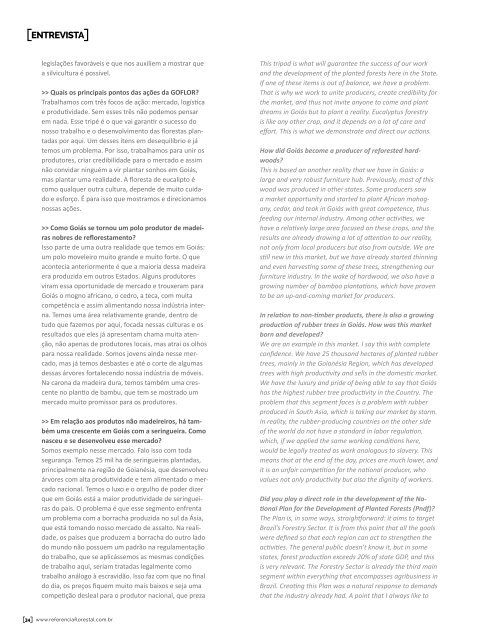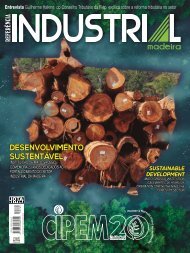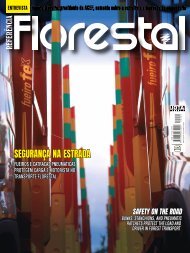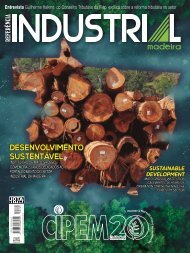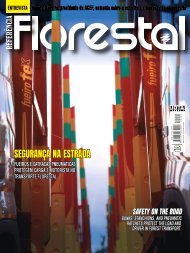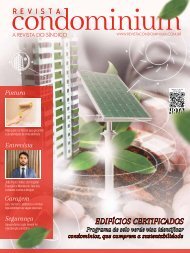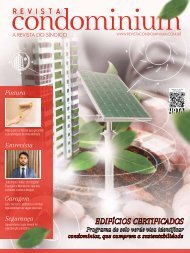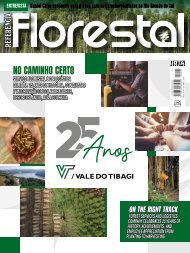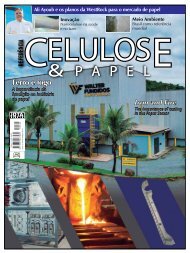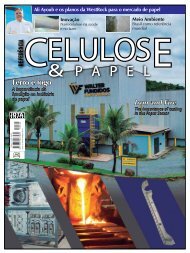Create successful ePaper yourself
Turn your PDF publications into a flip-book with our unique Google optimized e-Paper software.
ENTREVISTA<br />
legislações favoráveis e que nos auxiliem a mostrar que<br />
a silvicultura é possível.<br />
>> Quais os principais pontos das ações da GOFLOR?<br />
Trabalhamos com três focos de ação: mercado, logística<br />
e produtividade. Sem esses três não podemos pensar<br />
em nada. Esse tripé é o que vai garantir o sucesso do<br />
nosso trabalho e o desenvolvimento das florestas plantadas<br />
por aqui. Um desses itens em desequilíbrio e já<br />
temos um problema. Por isso, trabalhamos para unir os<br />
produtores, criar credibilidade para o mercado e assim<br />
não convidar ninguém a vir plantar sonhos em Goiás,<br />
mas plantar uma realidade. A floresta de eucalipto é<br />
como qualquer outra cultura, depende de muito cuidado<br />
e esforço. É para isso que mostramos e direcionamos<br />
nossas ações.<br />
>> Como Goiás se tornou um polo produtor de madeiras<br />
nobres de reflorestamento?<br />
Isso parte de uma outra realidade que temos em Goiás:<br />
um polo moveleiro muito grande e muito forte. O que<br />
acontecia anteriormente é que a maioria dessa madeira<br />
era produzida em outros Estados. Alguns produtores<br />
viram essa oportunidade de mercado e trouxeram para<br />
Goiás o mogno africano, o cedro, a teca, com muita<br />
competência e assim alimentando nossa indústria interna.<br />
Temos uma área relativamente grande, dentro de<br />
tudo que fazemos por aqui, focada nessas culturas e os<br />
resultados que eles já apresentam chama muita atenção,<br />
não apenas de produtores locais, mas atrai os olhos<br />
para nossa realidade. Somos jovens ainda nesse mercado,<br />
mas já temos desbastes e até o corte de algumas<br />
dessas árvores fortalecendo nossa indústria de móveis.<br />
Na carona da madeira dura, temos também uma crescente<br />
no plantio de bambu, que tem se mostrado um<br />
mercado muito promissor para os produtores.<br />
>> Em relação aos produtos não madeireiros, há também<br />
uma crescente em Goiás com a seringueira. Como<br />
nasceu e se desenvolveu esse mercado?<br />
Somos exemplo nesse mercado. Falo isso com toda<br />
segurança. Temos 25 mil ha de seringueiras plantadas,<br />
principalmente na região de Goianésia, que desenvolveu<br />
árvores com alta produtividade e tem alimentado o mercado<br />
nacional. Temos o luxo e o orgulho de poder dizer<br />
que em Goiás está a maior produtividade de seringueiras<br />
do país. O problema é que esse segmento enfrenta<br />
um problema com a borracha produzida no sul da Ásia,<br />
que está tomando nosso mercado de assalto. Na realidade,<br />
os países que produzem a borracha do outro lado<br />
do mundo não possuem um padrão na regulamentação<br />
do trabalho, que se aplicássemos as mesmas condições<br />
de trabalho aqui, seriam tratadas legalmente como<br />
trabalho análogo à escravidão. Isso faz com que no final<br />
do dia, os preços fiquem muito mais baixos e seja uma<br />
competição desleal para o produtor nacional, que preza<br />
This tripod is what will guarantee the success of our work<br />
and the development of the planted forests here in the State.<br />
If one of these items is out of balance, we have a problem.<br />
That is why we work to unite producers, create credibility for<br />
the market, and thus not invite anyone to come and plant<br />
dreams in Goiás but to plant a reality. Eucalyptus forestry<br />
is like any other crop, and it depends on a lot of care and<br />
effort. This is what we demonstrate and direct our actions.<br />
How did Goiás become a producer of reforested hardwoods?<br />
This is based on another reality that we have in Goiás: a<br />
large and very robust furniture hub. Previously, most of this<br />
wood was produced in other states. Some producers saw<br />
a market opportunity and started to plant African mahogany,<br />
cedar, and teak in Goiás with great competence, thus<br />
feeding our internal industry. Among other activities, we<br />
have a relatively large area focused on these crops, and the<br />
results are already drawing a lot of attention to our reality,<br />
not only from local producers but also from outside. We are<br />
still new in this market, but we have already started thinning<br />
and even harvesting some of these trees, strengthening our<br />
furniture industry. In the wake of hardwood, we also have a<br />
growing number of bamboo plantations, which have proven<br />
to be an up-and-coming market for producers.<br />
In relation to non-timber products, there is also a growing<br />
production of rubber trees in Goiás. How was this market<br />
born and developed?<br />
We are an example in this market. I say this with complete<br />
confidence. We have 25 thousand hectares of planted rubber<br />
trees, mainly in the Goianésia Region, which has developed<br />
trees with high productivity and sells in the domestic market.<br />
We have the luxury and pride of being able to say that Goiás<br />
has the highest rubber tree productivity in the Country. The<br />
problem that this segment faces is a problem with rubber<br />
produced in South Asia, which is taking our market by storm.<br />
In reality, the rubber-producing countries on the other side<br />
of the world do not have a standard in labor regulation,<br />
which, if we applied the same working conditions here,<br />
would be legally treated as work analogous to slavery. This<br />
means that at the end of the day, prices are much lower, and<br />
it is an unfair competition for the national producer, who<br />
values not only productivity but also the dignity of workers.<br />
Did you play a direct role in the development of the National<br />
Plan for the Development of Planted Forests (Pndf)?<br />
The Plan is, in some ways, straightforward: it aims to target<br />
Brazil’s Forestry Sector. It is from this point that all the goals<br />
were defined so that each region can act to strengthen the<br />
activities. The general public doesn’t know it, but in some<br />
states, forest production exceeds 20% of state GDP, and this<br />
is very relevant. The Forestry Sector is already the third main<br />
segment within everything that encompasses agribusiness in<br />
Brazil. Creating this Plan was a natural response to demands<br />
that the industry already had. A point that I always like to<br />
34 www.referenciaflorestal.com.br


